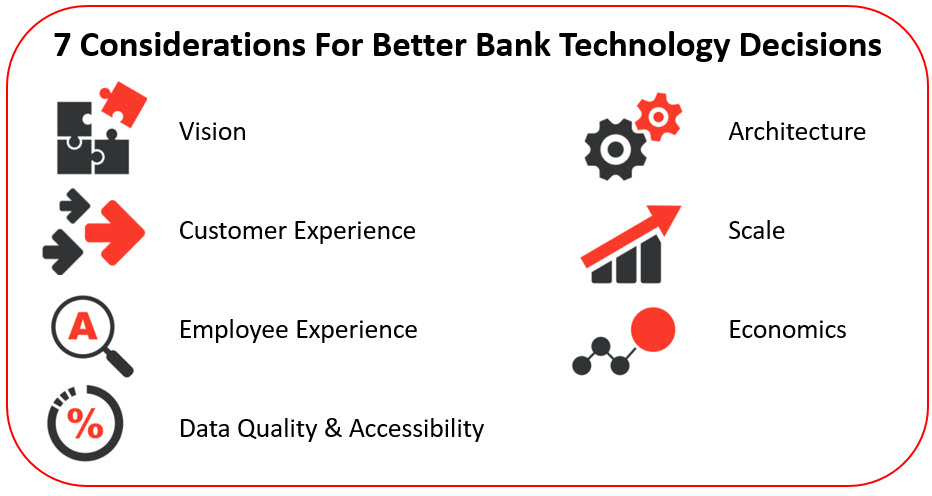
The largest problem with bank innovation is that we see or hear about a sexy piece of technology at a conference or at another bank and then acquire it. The new piece of technology ends up solving a known problem but in the process actually creates more problems, and risk, than it solves. It’s called the “Shiny Object Syndrome” (SOS), and it could be sowing the seeds of destruction for many banks. In this article, we look at the seven strategic questions you need to answer before acquiring any piece of technology.
Does The Technology Fit within the Bank’s Strategic Vision?
Often times, we get distracted by the latest technology trend or get enamored by how easy a piece of technology is to use or implement. Banks have limited resources and must choose their projects, and their priority, extremely carefully.

Blockchain and cryptocurrencies, for example, are fun to tout but it is the greatest solution to a problem we don’t have. No bank has a strategic need for better contracts, UCC filings, a new currency or whatever else this technology is going to solve. If this is the case, why even spend any more time that you need to on this tech?
Does It Improve The Customer Experience Across My Platform?
To answer the question, step one is to ask yourself how does the product scale across your platform to various customer segments. We all say the customer comes first, but our actions around innovation often put cost, compliance, or our present way of doing business first. At the micro-level, the SOS problem impacts small components of technology such as how you handle document storage, e-signature, ID verification, authentication, encryption, or the movement of money.
On a macro-level, it’s about managing your channels and your customer segments. There are thousands of banks in our industry that use a different application for their online banking channel than their mobile channel. The result is two different customer experiences that likely cannot be brought together. Further, what might work for retail may not work for small business or commercial, so then you have created a structure that inhibits your bank from ever achieving true cross-customer segment and cross-channel integration.
How Will My Employees Access The Technology?
Next, to having different customer experiences in banking technology, we make our employees have different experiences. Having your branch staff need twelve different log-ins does nothing but hurt the customer experience, increase training cost, jump risk, and add complexity to the system. After the customer, think about how the technology can be integrated for employees throughout the organization.
Where Will The Data Live and How Will The Data Move?
When banks complain about not having their data in one place, they have only themselves to blame. Having your customer data in the core, on spreadsheets, in Google Analytics, and in 25 other systems is a result of not thinking through your bank’s data scheme enough. At present, there is a myriad of off-the-shelf data products and services to solve this problem, but banks need to make data and data integrity a priority.
Having your data in different applications will do nothing but slow you down. Choose or build banking applications that make it easy to centralize your data into one place, and you will gain operational leverage.
Does The Technology Fit My Desired Future Architecture?
If your bank desires to move to real-time payment processing, don’t keep adding on batch-driven applications. Further, to the point above, if you require your data in one place, then choose or build an application with robust enough APIs to allow that movement of data.
How Does The Product Scale?
Your bank will likely grow, and one day, the technology you chose will have to support remote employees, customers outside of your branch network and customers across state lines. Make sure whatever technology you choose can grow with you in such a way that you gain operational efficiencies.
What Are The All-In Risk-Adjusted Economics?
The cost of the technology and integration is likely just the tip of the iceberg. Understanding how will you support the technology and what processes have to change as a result will give your bank a clearer picture of what they are getting into to. In costing a project, banks often leave out the cost of internally maintaining the system and the incremental labor effort associated with things like training, marketing, audit, and risk management.
Most new pieces of technology add additional complexity, so make sure you have not only documented the risk that the new application will have but also the risk and cost that the new application will reduce. It is true that digital account opening, for example, comes with a set of risks, but it also dramatically reduces the cost of traditional account opening and often comes with better fraud controls. However, that is just the direct cost and risk. Digital account opening also leverages your current branch network and allows few physical locations to be needed in the future.
See the big picture when it comes to calculating your return on investment, and your technology decisions will become easier.
Solving This Problem
The key to preventing getting mired in bad bank technology is to think through the above questions and then go out and ONLY search or build technology that fits with your requirements. Going to Finovate, getting involved with incubators or listening to random vendor demos is fun, but it supports banker’s worst instincts when it comes to technology. We all want the latest and greatest when it comes to technology, but this is why every bank has a garage full of underutilized technology and at cross-purposes to the bank’s stated goals.
Instead of letting technology drive the bank, get the answers to the seven questions above, and then drive technology. The end result will be that instead of adding additional cost, you will find that your technology will help reduce cost and make the customer happier in the process. That outcome is likely much more aligned to your strategic purpose than Bitcoin.





